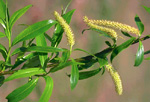 |
This family is almost worldwide in natural distribution except for Australasia, although most common in the cold to temperate parts of the Northern Hemisphere. In Australia it is represented by introduced trees of the temperate south, particularly common along watercourses and in wet areas where they may be serious weeds.
Characteristic features of the family Salicaceae in Australia include: - trees, often suckering vigorously and forming thickets
- leaves alternate, simple, usually toothed, pinnately (Salix) or palmately (Populus) veined
- flowers without a perianth, unisexual, borne in catkins
- fruit dry, splitting into 2 valves to release the seeds which often
float in the wind by means of a weft of long, soft hairs; many species
of Salix are sterile in Australia
Description
Deciduous or semi-deciduous trees or shrubs. Vegetative
reproduction absent, or by detached stem parts, bulbils, proliferous flowerheads
or root suckers. Internal secretions not obvious. Plants glabrous, or
with simple, non-glandular, unicellular or uniseriate hairs. Leaves alternate
and spiral, petiolate or subsessile. Stipules apparently absent, or present
and distinct and free from the petiole, scale-like or membranous, falling
off early or persistent. Lamina simple, symmetric, palmatifid or palmatisect,
lanceolate, ovate, elliptic, oblanceolate, oblong or orbicular; base cuneate,
attenuate, rounded, cordate, hastate, sagittate or truncate; margins entire,
crenate, dentate, serrate or sinuate, ±flat; venation pinnate,
or palmate, with the midrib conspicuous, and the tertiary venation reticulate
or not; surfaces not punctate; herbaceous; distinctive odour absent or
aromatic. Male and female flowers occurring on separate plants. Inflorescences
terminal or axillary, consisting of catkins, spikes or racemes. Bracts
and bracteoles present. Pollination by insects or wind. Flowers odourless,
sessile or stalked. Floral disc present or absent; nectaries absent or
present on the disc or the stamens. Free hypanthium present or absent.
Perianth absent. Fertile stamens 1–numerous, free of the ovary and style,
distinct from each other or fused by their filaments into an open or closed
tube, all ±equal. Anthers basifixed, not versatile, opening sideways
by longitudinal slits, 2-celled. Ovary superior and sessile. Carpels 2,
fused; ovary with 1 locule. Style terminal, single and branched above
or from the base. Ovules (2–) 4–numerous, stalked; placentation parietal.
Fruit a dry, dehiscent denticidal capsule. Seeds (2–) numerous per fruit.
Disseminule macro-surface with crimped or cottony hairs; micro-surface
±smooth, straw- or ochre-yellow, grey or rarely black, Aril absent.
Cotyledons 2. Embryo straight.
(Note: this description has been generated from the coded data compiled for the key. Any errors in the key data will be reflected in the descriptions.)
A treatment of the family Salicaceae has been published in:
Flora of Australia 8: 200-206.
Australian genera of Salicaceae (as recognised for the Flora of Australia)
* = all species introduced
*Populus
*Salix

|
  |

Salix alba (flowering branch)
Photo: S.Jacobs © S.Jacobs
|
 |
|